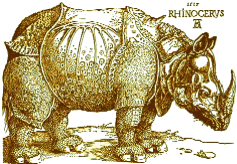
 |
Group of History and Theory of Science |
|
|
|
|
|
|
Other Internet pages, on César Lattes and the discovery of the pi meson (in Portuguese), containing photographs:
Yukawa and Lattes
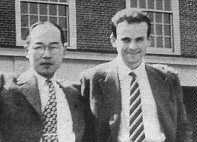
In 1935, the Japanese theoretical physicist Hideki
Yukawa proposed an explanation of nuclear forces. He suggested the existence
of a new particle, with a mass about 200 times larger than that of the
electron. The unknown particle was supposed to be emitted and absorbed
by protons and neutrons. The exchange of those particles between the constituents
of the atomic nucleus would produce a short-range attraction between them
that would explain the stability of the nucleus. This particle received
the name "meson" (from the Greek "mesos" = intermediate) because its mass
was intermediate between those of the electron and of the proton. According
to Yukawa's theory, mesons can only exist for a very short time. Outside
the atomic nucleus, they were supposed to disintegrate in just one thousandth
of a millionth of one second.
In 1937-38, Carl D. Anderson and Seth H. Neddermeyer
found in the cosmic radiation, that continually reaches the ground, signs
of something that looked like Yukawa's meson: it has the expected mass
and disintegrated as Yukawa's particle was expected to disintegrate. For
ten years, it seemed that everything fit in the scheme, and that there
was a nice theory on the constitution of matter. In 1947, however, this
peace was shaken. It became clear that the meson of Anderson and Neddermeyer
did not behave as predicted by Yukawa's theory.
Mesons should be strongly absorbed by protons and
neutrons, if they are to explain nuclear forces. It was predicted, therefore,
that they should be easily captured by matter. However, a group of Italian
physicists (Marcello Conversi, Ettore Pancini and Oreste Piccioni) observed
that those mesons that had been found in cosmic radiation could pass through
several hundred atomic nuclei without suffering any interaction. They had
a very weak interaction with protons and neutrons – the opposite of what
was expected. Something was going wrong.
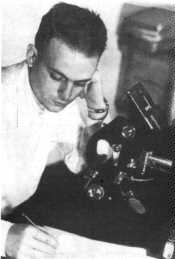 |
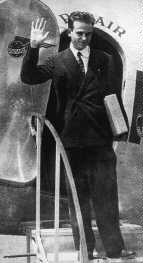 |
César Lattes, in 1947 |
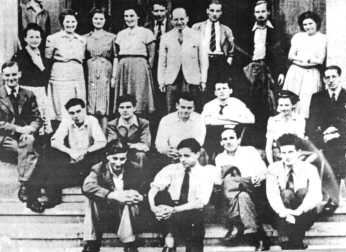
The cosmic ray laboratory at
Mount Chacaltaya, when it was being built
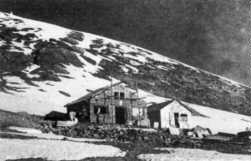
What could that be? There were several possible
interpretations. Perhaps the meson had reacted with an atomic nucleus inside
the emulsion, and after the interaction it could have been expelled with
a larger speed. Perhaps the meson could have suffered some sort of transformation
into another kind of meson. The two initial cases were insufficient evidence
to reach any safe conclusion. In order to obtain a larger number of tracks,
Lattes traveled to Bolivia, and put several nuclear plates at the top of
Mount Chacaltaya, 5,500 m above the sea level. When the plates were developed,
it was possible to find about 30 tracks of double mesons. A detailed study
led to the determination of the meson masses, and it was possible to establish
that there were indeed two types of mesons, with different masses.
One of the mesons was about 30% or 40% heavier than
the other one. The heavier meson was able to disintegrate and to produce
the lighter meson. The second particle was the one that was already known
from the studies of Anderson and Neddermeyer. To distinguish it from the
other one, it was called "mu meson" (nowadays, it is called "muon"). The
primary meson, on the other side, was something new, unknown. It was called
"pi meson", and its identification was announced in October 1947. Later
tests showed that it strongly interacted with nuclei and that its characteristic
properties were those required by Yukawa's theory. The particles that hold
the nucleus together had been found.
The discovery of the pi meson was not merely a confirmation
of a theory. It opened a whole new world to investigation. First, because
it became clear that there were particles (muons) that had not been predicted;
their role in nature was unknown. Secondly, because the study of cosmic
rays soon led to the unexpected discovery of several other particles. In
that same year, several tracks that did not correspond to anything known
were detected.
Powell's group found evidence for a kind of meson
twice as heavy as pions. They were called "tau mesons" at first, and nowadays
they are called kappa mesons. In the same year (1947), Clifford Butler
and George Rochester observed V shaped tracks. They could be explained
assuming the existence of new neutral particles (without electric charge)
that produced no track and that disintegrated into one positive and one
negative particle. In the following years, physics was flooded by new,
unexpected particles. It was difficult to understand their properties,
at that time. Robert Oppenheimer introduced the phrase "sub nuclear zoo"
to describe this new world of particles. Among the exotic animals of this
zoo, there were particles heavier than protons (the so-called "hyperons"),
of several different types. The new "animals" were first studied in cosmic
rays, but powerful particle accelerators were soon built – each one more
powerful than the former – and they allowed the creation and investigation
of those particles in the laboratory.
The discovery of the pi meson was something more
than finding one special particle. It heralded the beginning of a deep
revision of the physical concepts on the structure of matter. The large
variety of particles that were discovered in the following years challenged
the very concept of "elementary particle" as something indivisible, simple.
It led to the search for a substructure for protons, mesons and the other
particles. The theory of quarks would never arise without the stimulus
of those empirical discoveries, that began 50 years ago.
On the 24th May 1947, the British journal Nature published the paper "Processes involving charged mesons", authored by Cesar Lattes, H. Muirhead, G. P. S. Occhialini and C. F. Powell. You can get an electronic copy of the full paper here (The file lattes.zip is 82.3 kB large; it can take some time to be transferred by Internet).
Attention: The copyright of this article belongs to Nature. Our electronic library can provide a digital copy of the paper, to any individual researcher, without the necessity of copyright payment, exactly as a traditional (paper) library can provide a xerox copy of the article. Anyone who might obtain here a copy of the article must be aware that he/she is only allowed to use the provided copy for individual research. Any other use is forbidden.
First click the sentence above, then use your navigator's "save as" resource to save the compacted file (lattes.zip). Afterwards, use any software such as pkunzip, winzip, etc., to obtain the files that contain the text and figures of César Lattes' paper.
|
|
|
|
|
|
Group of History and Theory of Science
Caixa Postal 6059, 13081-970 Campinas, SP, BRAZIL
This page was updated on 03/Apr./1998